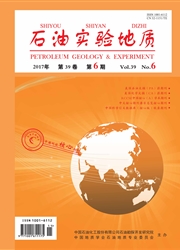

 中文摘要:
中文摘要:
对三塘湖盆地马朗凹陷主要探井的岩心进行了观察、取样,明确了烃源岩区别于火山岩尤其是凝灰岩的测井响应特征,并通过地质背景与实际井震对比分析,以火山岩与烃源岩的共生关系为依据,通过数学计算模型预测了本区石炭系各主要源岩层系的烃源岩分布。研究结果表明,本区火山岩系共发育两大类烃源岩赋存型式,在火山岩与烃源岩之间存在4种共生关系,测井—地震响应特征明显。石炭系哈尔加乌组和卡拉岗组火山岩与烃源岩的接触关系不同,分属2种不同的火山岩系烃源岩赋存型式,适用于不同的烃源岩厚度数学预测模型。烃源岩分布预测结果表明,卡拉岗组火山岩为陆上喷发,烃源岩空间上与火山岩相隔、独立、正常沉积,分布相对局限;哈尔加乌组火山岩为水下喷发,烃源岩分布广泛但在火山口之间形成多个次级厚度中心,平面分布非均质性较强。
 英文摘要:
英文摘要:
The formation of volcanic reservoirs in the Malang Sag, the Santanghu Basin is obviously controlled by the distribution of hydrocarbon source rocks. As a result, the identification and prediction of source rocks in the volcanic systems are significant for petroleum exploration. Some core samples have been collected from the study area to cali-brate the logging response of source rocks. The distribution of source rocks in different formations of Carboniferous is predicted through mathematical modeling based on the comparison between geologic background and actual logging data, and combined with the symbiotic relationship between source rocks and volcanic rocks. The occurrence of source rocks in the volcanic systems can be categorized into two types, and volcanic rocks coexist with source rocks in four ways, showed by distinctive logging-seismic responses. The contact relationships between source rocks and volcanic rocks in the Haerjiawu and Kalagang formations are quite different, referring to two occurrence types which should be studied with different mathematical models. The Kalagang source rocks are separate and limited in space formed in the normal sedimentation not belonging to the onshore volcanic system. The Haerjiawu source rocks are widespread, forming multiple thickness centers between volcanic vents.
 同期刊论文项目
同期刊论文项目
 同项目期刊论文
同项目期刊论文
 期刊信息
期刊信息
